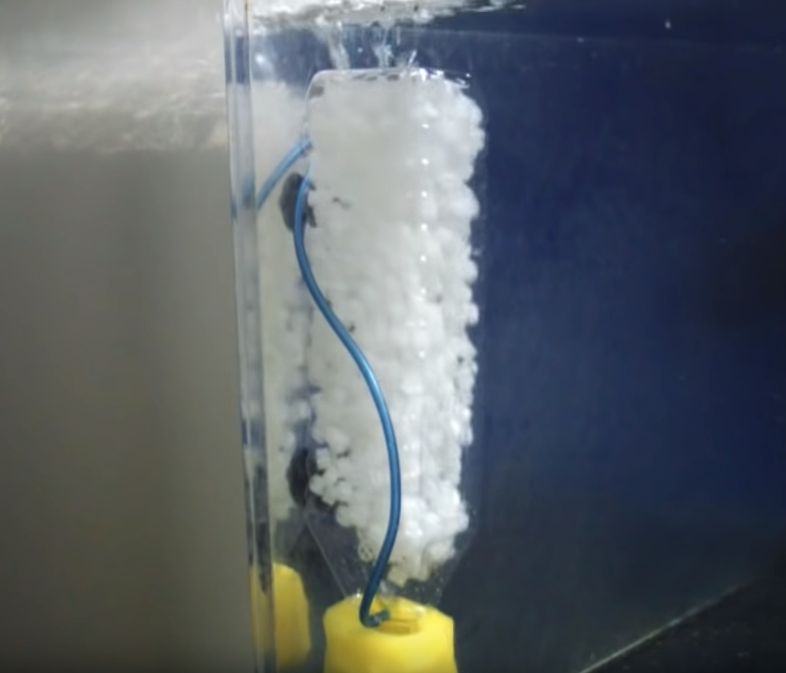
Another filter made famous by Joey Mullens (the very knowledgeable and immensely likeable “King of DIY”) is a bottle filter. It has many variations but in its simplest form it is an 16-ounce inverted water bottle with an air tube from an air pump inserted in the neck, some foam over the spout, and holes in the flat bottom of the inverted bottle. There is media such as half inch lava rock or ceramic rings put in the bottle and air bubbles are bubbled up through the media. This is a very cheap filter.
It is also a very poor filter. The problem is twofold: there is very little media and there is very little flow. The tube coming out of a sponge filter or an under-gravel filter is called a lift tube for a reason. A column of small rising bubbles lifts water with it and creates a small flow. In the case of the typical sponge filter this is roughly ten to twenty gallons per hour.
In a bottle there is no lift THROUGH the holes in the top of the bottle. Greatly simplified, the bubbles do not “push” the water up and out. The water rising with the bubbles simply recirculates to the bottom of the bottle. So, it’s a stretch to say a bottle filter moves one quart per hour of water through it. If it’s in a 25-gallon aquarium the water goes through the filter once every two days. Thus, there is very little filtration.
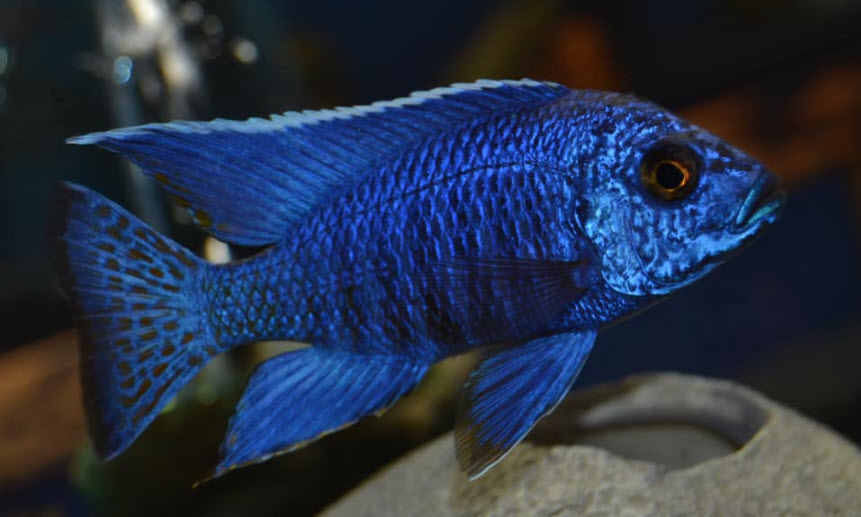
The proof of this is simple. I took a bottle filter in operation and injected the bottle with red food dye through plastic pipette. The red colored filled the bottle. The dye then remained there for about one hour before finally dissipating into the aquarium. There was very little flow THROUGH the bottle into the aquarium to disperse the dye. This low flow through will not filter water very well.
Joey made one video where he says a bottle which uses K1 media in it in a fluidized bed design is a much worse filter than the bottle filled with ceramic media. Joey is buying into the hype about surface area in ceramic media and is technically 180 degrees incorrect, the K1 fluidized bed bottle filter will be much better than the ceramic media bottle filter. But the whole argument is pointless as neither K1 or ceramic in a bottle filter will do even a decent job of filtration.
To his credit Joey apparently read this article and changed the design of his bottle filters to include sponge and an air lift tube. His new design will work much better.
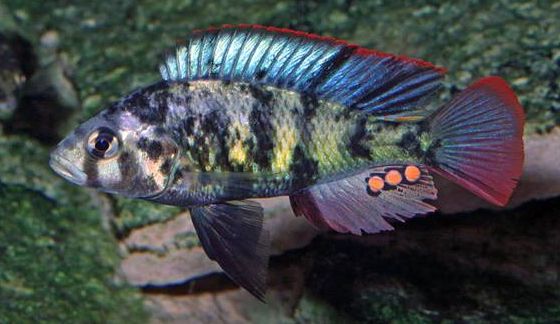
Making the Bottle Filter Work
Now, if one adds a lift tube to the top of the bottle instead of simply some holes and don’t invert the bottle, things change radically. A lift tube makes the bottle filter about equivalent to a sponge filter. Joey’s design can be made into a decent filter:
- Don’t have any foam.
- Turn the design upside down, with the neck of the bottle at the top
- Put the cap back on the bottle and drill several many small holes in the cap
- Put many small holes in the bottom of the bottle
- Fill the bottle with media (prefer pot scrubbers or K1)
- Glue on a six to eight-inch length of piping to the neck of the bottle (3/4-inch schedule 80 PVC works great on a typical one or two liter water bottle)
- Put an air line glued to the bottom of the lift tube, or route the air line through the bottle up through the cap and into the bottom of the lift tube.
- Turn on the air. The air will rise up through the lift tube. As the air moves up the lift tube it takes water with it, creating a flow in the bottle.
The lift tube will then move the water through the bottle at a decent clip.
A version of such a bottle filter is shown below:

A variant of this design is to put the air line into the bottom of the bottle filter, making the air rise through the bottle, into the tube through the cap. If this filter is loaded 60% with K1 micro media ($20 per liter) it will make a fluidized bed filter for a small aquarium. An even better variant can be made with any of the many containers found in Walmart in the kitchen goods section. Square cross section quart bottles are especially attractive for a decent sized fluidized bed internal corner filter.
Unfortunately such filters have a problem. The bubbles coalesce as they rise through the K1 media and through the lift tube. This means these filters are very noisy, with LOTS of gurgling.
There are a whole series of small do it yourself filter designs in this article:
8.7.8 Small DIY Filters
Ziss Bubble Bio Moving Bed Filter
Note that the Aquarium Co-op is selling a small commercial fluidized bed filter called the Ziss Bubble Bio Moving Bed Filter. This is basically a commercial version of Joey’s bottle design. Other manufacturers are coming out with variations on this design.
The Ziss unit has the same shortcomings as Joey’s bottle design. Without a lift tube air move through the filter the water doesn’t move through the filter. So the aquarium water might get into the filter once every 2 days. This just won’t give good filtration.
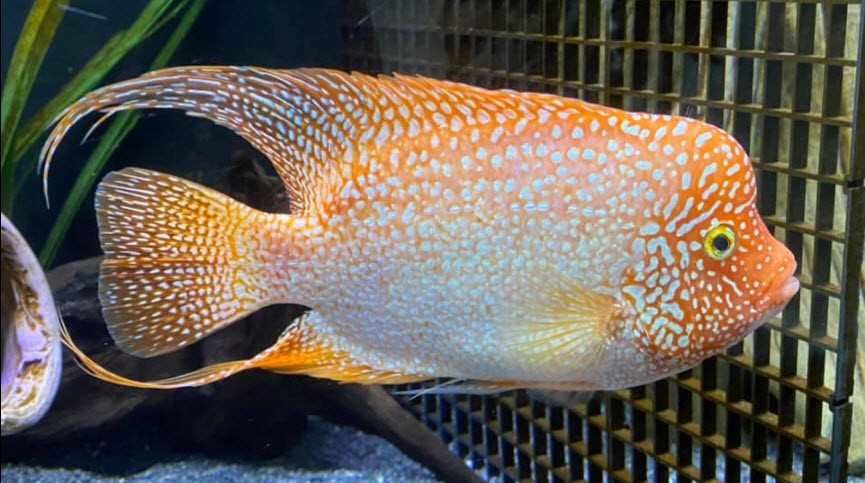
Circulation in a Bottle Filter in Greater Depth
To say that the bubbles don’t “push out” the water in a bottle filter is a great simplification. In actuality with this design of an air driven bottle filter there are two possibilities:
- There are a few small holes on top (actually the bottom) of the bottle. There is a single source of bubbles at the base of the bottle. The bubbles create a small flow of water up AND down, and the water doesn’t move THROUGH the bottle at all. This type filter has the circulation necessary to become fluidized.
- There are lots of large holes on top (actually the bottom). There are multiple sources of bubbles in the bottom of the filter. The bubbles create a single rising column of water that ONLY goes up, and the water moves THROUGH the bottle freely. This type filter does NOT have the circulation pattern required of a fluidized bed.
So the take away is that a static bed bottle filter with the likes of pot scrubbers in it needs a lot of aeration over a wide area and more hole on top than plastic. This basically makes the whole bottle a lift tube and will move the water through the pot scrubbers. But I have yet to see a design that can successfully do this. This is a LOT of air.
This all has to do with the fact that bubbles do not “push” water up. Water moves up in an air lift because the entire column of the water is filled with bubbles. This makes the entire column of water in the tube a lower density that the surrounding water. And the water in the lift tube literally floats upward. An air stone without a tube moves much smaller amounts of water than does an air stone in a tube.
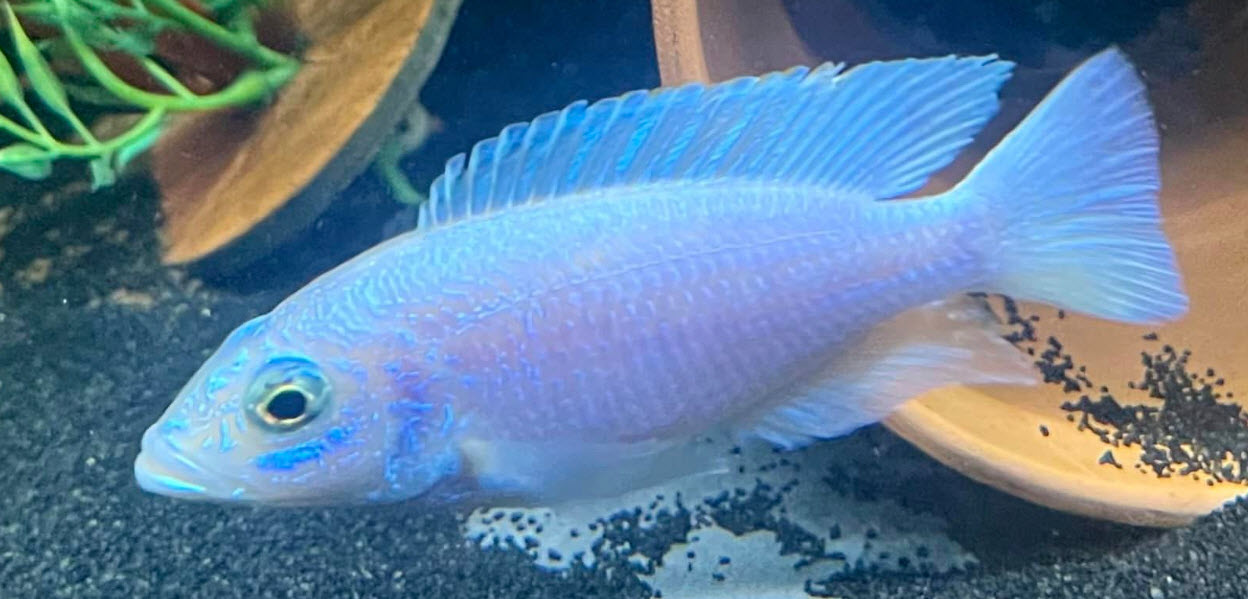
Small Filters Which WILL Work
For more information on small filters for the small aquarium click on these links:
8.7.6. Small Filters
8.7.8 Small DIY Filters
.
Return to Filter Menu
Return to Miscellaneous Filters Menu
.
Aquarium Science Website
The chapters shown below or on the right side in maroon lead to close to 400 articles on all aspects of keeping a freshwater aquarium. These articles have NO links to profit making sites and are thus unbiased in their recommendations, unlike all the for-profit sites you will find with Google. Bookmark and browse!
.

Dave says
In reply to Cameron…. I like it! You are 100% correct and the system should work out just fine. And you can get aeration with other means, such as powerheads creating choppy waves.
Cameron says
Hi Dave,
To get the full benefit of fluidized K1 when using water rather than air for motion, does the K1 need to break the surface of the water, or is it sufficient that the tank is aerated by a powerhead making choppy surface waves elsewhere in the tank?
In a 30 gal, I’ve immersed an Aquamaxx FR-M media reactor, removed the diffusion plate and sponges, and filled it 60% with micro K1. The pump gives it a nice tumbling action, driving water up from the bottom and out the top. I’m calculating this as .7 L (43 ci) of fluidized K1, so it should support about .13 lbs of fish. My water is clear, and it’s almost silent.
I’d like to be sure this method counts as properly fluidized K1 (i.e. 320 cu in to get 100 sq ft) before I add any more bioload.
Dave says
In reply to Fecundo … Pump intakes in a fluidized bed typically work better in a separate chamber.
Facundo Bozza says
Hello Dave,
I am thinking if making a vertical division of the aquarium with a drilled acrylic plate and adding k1 with aireation and a pump for renovating the water could work.
Do you think that the pump intake flow could interfere in the proper movement of the k1? Maybe adding another divison for separating de pump from the k1. Thank you for answering my previous questions, you are really helping me.